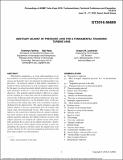Unsteady Adjoint of Pressure Loss for a Fundamental Transonic Turbine Vane
Author(s)
Laskowski, Gregory M.; Talnikar, Chaitanya Anil; Wang, Qiqi
DownloadV05AT13A009-GT2016-56689.pdf (2.035Mb)
PUBLISHER_POLICY
Publisher Policy
Article is made available in accordance with the publisher's policy and may be subject to US copyright law. Please refer to the publisher's site for terms of use.
Terms of use
Metadata
Show full item recordAbstract
High fidelity simulations, e.g., large eddy simulation are often needed for accurately predicting pressure losses due to wake mixing and boundary layer development in turbomachinery applications. An unsteady adjoint of high fidelity simulations is useful for design optimization in such aerodynamic applications. In this paper we present unsteady adjoint solutions using a large eddy simulation model for a vane from VKI using aerothermal objectives. The unsteady adjoint method is effective in capturing the gradient for a short time interval aerothermal objective, whereas the method provides diverging gradients for long timeaveraged thermal objectives. As the boundary layer on the suction side near the trailing edge of the vane is turbulent, it poses a challenge for the adjoint solver. The chaotic dynamics cause the adjoint solution to diverge exponentially from the trailing edge region when solved backwards in time. This results in the corruption of the sensitivities obtained from the adjoint solutions. An energy analysis of the unsteady compressible Navier-Stokes adjoint equations indicates that adding artificial viscosity to the adjoint equations can dissipate the adjoint energy while potentially maintain the accuracy of the adjoint sensitivities. Analyzing the growth term of the adjoint energy provides a metric for identifying the regions in the flow where the adjoint term is diverging. Results for the vane from simulations performed on the Titan supercomputer are demonstrated.
Date issued
2016-06Department
Massachusetts Institute of Technology. Department of Aeronautics and Astronautics; Massachusetts Institute of Technology. Computation for Design and Optimization ProgramJournal
Volume 5A: Heat Transfer
Publisher
ASME International
Citation
Talnikar, Chaitanya, Qiqi Wang, and Gregory M. Laskowski. “Unsteady Adjoint of Pressure Loss for a Fundamental Transonic Turbine Vane.” Volume 5A: Heat Transfer (June 13, 2016).
Version: Final published version
ISBN
978-0-7918-4978-1